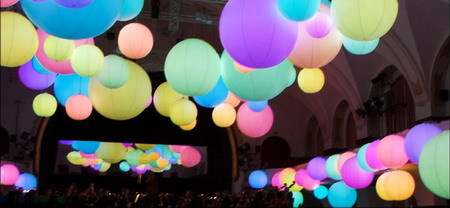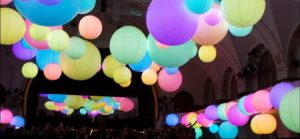In December 2008, the Jena Philharmonic Orchestra, at the Volkshaus in Thuringia (in Germany), performed works by composers Alexander Scriabin, Igor Stravinsky and Georg Friedrich Haas in a concerthall filled with 170 weather balloons that changed color to complement and enhance the music.
The LED-driven, light-art concert culminated a joint-development effort between an artist and members of the Future Lighting Solutions network, and fulfilled Scriabin’s early-20th-century vision of marrying color to music by utilizing 21st-century solid-state lighting.
The unusual light/music event was inspired by Scriabin’s 1910 “Prometheus: Poem of Fire” Symphony, written for orchestra, piano, voice and a piano-like “color organ,” called a Luce, designed to project colored light onto an on-stage screen. Some musicologists believed, however, that Scriabin’s original intention was to flood the entire concert hall with color and that he abandoned the idea when it proved to be technically unfeasible.
Thus, tech-savvy music lovers commissioned Stuttgart-based light artist Rosalie to create a color-changing installation to accompany the “Prometheus” Symphony, as well as Stravinsky’s “Firebird Suite” and a piano sonata by contemporary Austrian composer Haas. The project was dubbed “Luce: The Sound of Color.”
Scriabin characterized colors with emotions and metaphors. His red was a “color of Abaddon,” blue, a color of reason, and violet, a spiritual color.
Advertisement
Supersized balloons, which hung throughout the concert hall, changed color on a pre-programmed schedule that paralleled the music’s mood and tempo. The system incorporated RGB LED modules built with Philips Lumileds’ Luxeon® Rebel LEDs, as well as a closed-loop color-and-brightness management system to achieve color consistency from balloon to balloon. The balloons and color changes were also reflected on a mirror behind the orchestra to amplify the effects of the installation.
Future Lighting Solutions supplied the Luxeon LEDs and the tools and services to help ensure color uniformity in the LEDs themselves. Proprietary Future tools were used to calculate the achievable chromaticity coordinates to determine which color bins were required to produce the required color values. Future’s binning program then ensured that every balloon would be illuminated by LEDs from the same bin of each color in Future’s managed inventory.
MAL Effekt, a German-based Future Lighting Solutions Integration Network Member, designed and manufactured the LED modules, which were mounted on aluminum tubes inserted into each balloon. MAL Effekt also developed a custom, DMX512 power module that drove the LEDs, generated the desired colors, and controlled color point and brightness via pulse width modulation (PWM).
MAZeT GmbH, another Future Lighting Solutions partner, supplied color sensors that monitored the color produced by the RGB modules and sent the information from a central DMX512 control panel to a custom MAZeT electronic for any necessary adjustments to ensure the homogeneity of color tones from balloon to balloon. The Jencolor color sensors were developed by MAZeT and manufactured by Jenoptik.
Alexander Nicholayevich Scriabin (1872-1915) first became a concert pianist, though he had unusually small hands, then a composer of romantic symphonies, preludes and etudes. In 1905, he met Helen Blavatsky and embraced her theosophical ideas in his music, which he began to create as a bridge to mystical ecstacy, through chromatic effects and harmonic transformations,
In his later years, Scriabin worked on an immense piece, “Mysterium.” He planned for the seven-day-long megawork to be performed at the foothills of the Himalayas in India. Bells suspended from clouds would summon spectators. Sunrises would be preludes, and sunsets, codas. Flames would erupt in shafts of light and sheets of fire. Perfumes would pervade the air.
Advertisement
When he died, Scriabin left 72 orchestral-size pages of sketches for a preliminary work, “Prefatory Action,” with which he intended to “prepare” the world for the apocalyptic, ultimate masterpiece.



 Tip Sheet2 weeks ago
Tip Sheet2 weeks ago
 Photo Gallery3 days ago
Photo Gallery3 days ago
 Ask Signs of the Times5 days ago
Ask Signs of the Times5 days ago
 Real Deal2 weeks ago
Real Deal2 weeks ago
 Paula Fargo17 hours ago
Paula Fargo17 hours ago
 Benchmarks1 week ago
Benchmarks1 week ago
 Photo Gallery18 hours ago
Photo Gallery18 hours ago
 Women in Signs2 weeks ago
Women in Signs2 weeks ago










